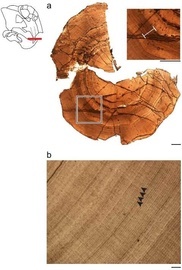Evidence of seasonal torpor in an Early Triassic Antarctic Lystrosaurus.
[sciencythoughts.blogspot.com]
Antarctica is today the coldest and driest continent with extreme variation in light availability throughout the year, restricting vertebrate life to coastal regions and rendering most of the continent uninhabitable. These modern environmental conditions are anomalous, however, considering the deep history of life in Antarctica when flora and fauna occupied large regions of the continent. Although more habitable with a warmer climate than today, Antarctica remained at a high latitudinal position for much of the Phanerozoic, subjecting its inhabitants to extreme photoperiod seasonality. Extant Vertebrates living in highly seasonally variable climates have evolved a variety of mechanisms to curb the effects of regular intervals of stress including daily torpor, hibernation, and brumation. These adaptations are largely behavioral thus rendering them difficult to study directly in the fossil record. Importantly, however, these adaptations reflect underlying metabolic changes in response to resource limitations, and therefore should be recognisable in fossil hard tissues that preserve chronological records of physiology.


Enjoy being online again!
Welcome to the community of good people who base their values on evidence and appreciate civil discourse - the social network you will enjoy.Create your free account
Recent Visitors 13
Photos 292 More
Posted by JoeBKite-like structures in the western Sahara Desert.
Posted by TriphidAn Aussie Indigenous Message Stick.
Posted by TriphidIndigenous Australian Aboriginal Rock art dated somewhere between 20 and 30 thousand years old.
Posted by TriphidIndigenous Australian Aboriginal Rock art dated somewhere between 20 and 30 thousand years old.
Posted by TriphidIndigenous Australian Aboriginal Rock art dated somewhere between 20 and 30 thousand years old.
Posted by TriphidIndigenous Australian Aboriginal Rock art dated somewhere between 20 and 30 thousand years old.
Posted by JoeBDortoka vremiri: A new species of Dortokid Turtle from the Late Cretaceous of the Hațeg Basin, Romania.
Posted by JoeBThe Cabeço da Amoreira burial: An Early Modern Era West African buried in a Mesolithic shell midden in Portugal.
Posted by JoeBMusivavis amabilis: A new species of Enantiornithine Bird from the Early Cretaceous Jehol Biota of northeastern China.
Posted by JoeBTorosaurus in Canada.
Posted by JoeBStone tools from the Borselan Rock Shelter, in the Binalud Mountains of northeastern Iran.
Posted by JoeBDating the Lantian Biota.
Posted by JoeBBashanosaurus primitivus: A new species of Stegosaur from the Middle Jurassic of Chongqing Municipality, China.
Posted by JoeBDetermining the time of year when the Chicxulub Impactor fell.
Posted by JoeBSão Tomé and Príncipe: Possibly the last country on Earth never to have been visited by a working archaeologist.
Posted by JoeBMambawakale ruhuhu: A new species of Pseudosuchian Archosaur from the Middle Triassic Manda Beds of Tanzania.






